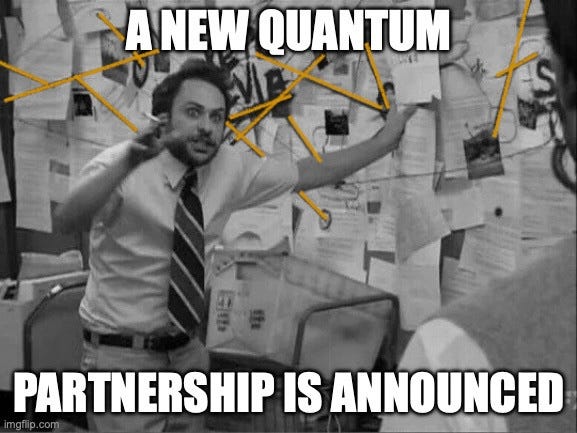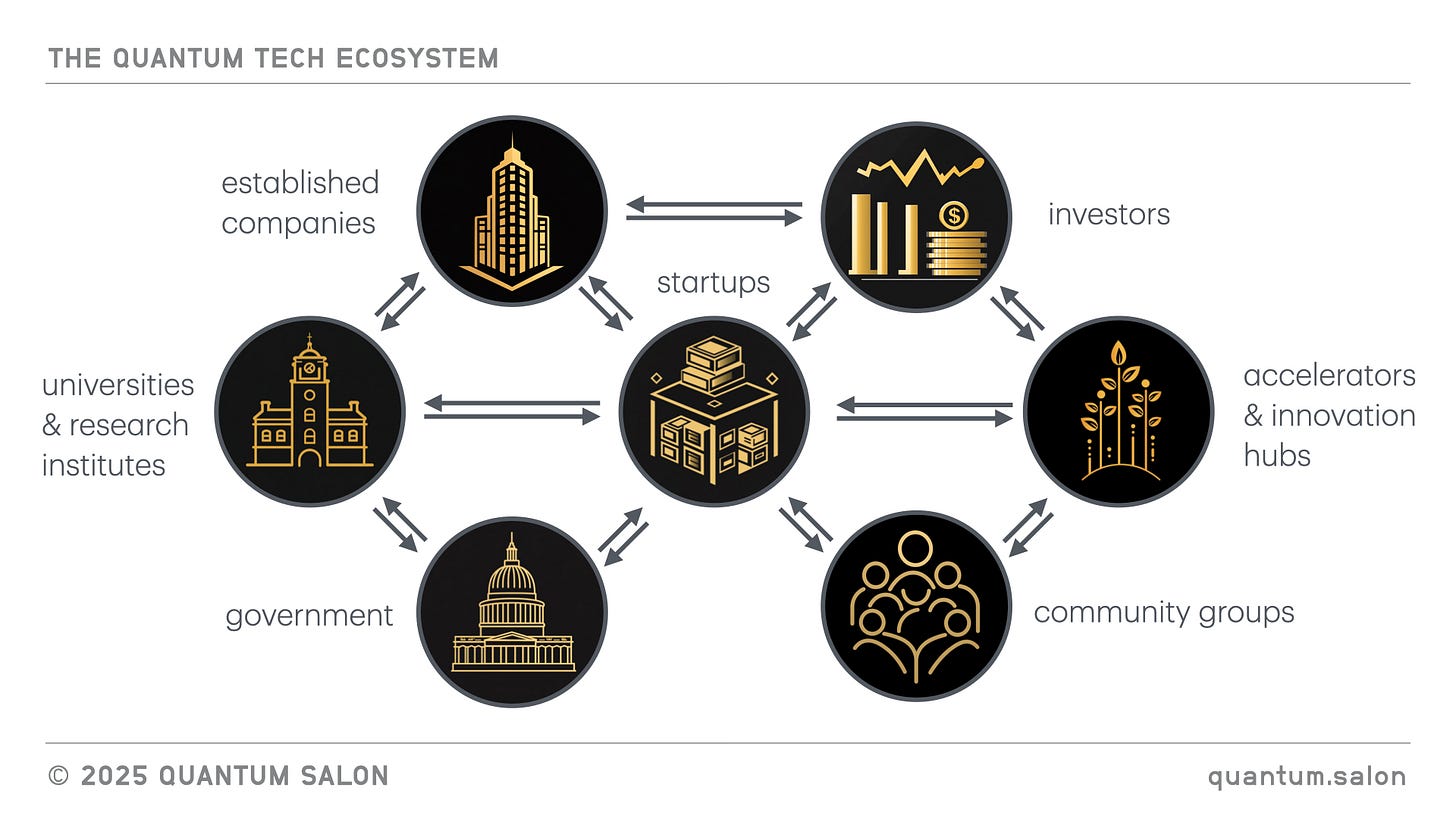How to Read Quantum Technology News
A practical guide for newcomers navigating news in the quantum tech ecosystem
If you're new to the world of quantum tech, you might be feeling a little bit overwhelmed. Not just with the complexity of the technology, but with the amount (and variety) of news covering developments in the ecosystem.
Breakthrough announcements seem to be dropping constantly. Funding rounds are in the headlines. New partnerships are getting announced left, right, and center.
And if you're like most people entering this field (or even if you’ve been in the field for a while!) you're probably wondering:
What does it all mean? How do I know what actually matters?
It turns out, like with most tech news, news about quantum technologies serves many purposes beyond just informing you about technical progress. Understanding who's communicating what to whom (and why) will help you cut through the noise and focus on what's genuinely significant for your interests and goals.
The quantum news ecosystem isn't just about the science
Quantum technologies operate at the intersection of cutting-edge research, venture capital, national security, and intense international competition. This creates a unique information environment where the same development can be presented very differently depending on the source and audience.
Consider an example: a company announces improved quantum sensor sensitivity. This single development generates multiple stories. The academic paper focuses on the experimental methodology. The company press release emphasizes the path to commercial advantage. The government report highlights national competitiveness implications. The investment newsletter talks about market timing.
None of these perspectives are wrong, but they're serving different audiences with different needs.
Your job as a reader is to understand which lens you're looking through and what the speaker is trying to accomplish.
A framework for understanding quantum news
Here's a practical way to categorize the quantum technology news you'll encounter.
Technical research announcements typically come from universities, national labs, or company R&D teams. These are usually about fundamental advances like better quantum error correction, new types of quantum devices, or novel quantum algorithms. The timeline to practical impact is often measured in years or decades, but these developments form the foundation for everything else.
Product and platform news comes from companies ready to sell you something today. This includes new quantum cloud platforms, software development kits, quantum sensors, or quantum communication systems. The timeline is immediate, but the practical capabilities may be limited to specific use cases or early adopters.
Business and market updates cover funding rounds, partnerships, and strategic announcements. These stories are often more about positioning and market dynamics than technical capabilities. A major partnership announcement might signal that a quantum technology is becoming more mainstream, even if the underlying technology hasn't fundamentally changed.
Workforce and education news has become increasingly prominent as the industry faces talent shortages. This includes job market reports, educational program launches, professional certification announcements, and skills gap studies. With these shortages, workforce development is now a strategic priority across the industry.
Policy and international strategy includes government quantum initiatives, export controls, and competitive positioning between nations. These stories often involve massive funding announcements, national security implications, and cross-border collaborations or restrictions. The timeline is typically long-term but the geopolitical stakes are high.
Infrastructure and ecosystem development covers the building of quantum innovation hubs, supply chain initiatives, and the physical infrastructure needed to support the quantum economy. This includes everything from new fab facilities to quantum cloud access programs that democratize the technology.
Reading between the lines
Every quantum technology announcement has multiple audiences, and understanding this helps you extract the right information for your needs.
When a startup announces a funding round, they're not just telling you they raised money. They're signaling to potential customers that they're stable and growing. They're telling competitors that they're a serious player. They're reassuring employees that jobs are secure. And they're laying groundwork for future funding rounds.
When a tech giant announces a new quantum service, they're not just launching a product. They're establishing themselves as the platform other companies will build on. They're attracting developers to their ecosystem. And they're signaling to the market that quantum technologies are moving from research to early commercial applications.
When a government announces a national quantum initiative, they're not just funding research. They're signaling to allies and competitors that this technology is strategically important. They're encouraging domestic industry development. And they're often responding to similar initiatives from other countries.
Practical tips for quantum news consumption
Follow the timeline clues. Research breakthroughs typically have 5-15 year timelines to practical impact. Product announcements are about capabilities available today (though often limited). Business news is about market positioning for the next 1-3 years. Workforce and education initiatives can take 3-10 years to show results.
Pay attention to the source. Academic papers undergo peer review and tend to be more conservative in their claims. Company press releases are marketing materials. Government reports often emphasize strategic implications over technical details.
Look for independent validation. The most significant developments usually generate coverage from multiple independent sources. If only one organization is reporting a "breakthrough," approach with healthy skepticism.
Understand the competitive landscape. Quantum technologies involve intense competition between countries, companies, and technological approaches. This competitive dynamic influences how news gets framed and what gets emphasized.
Focus on trends, not individual announcements. One company claiming a new record might be an outlier. Multiple companies achieving similar results suggests genuine progress.
What actually matters for different goals
If you're considering quantum technologies for business applications, focus on product announcements from established players, partnership news between quantum companies and enterprises in your industry, and use case demonstrations that solve real problems.
If you're interested in investment opportunities, pay attention to funding patterns, market size estimates, and news about talent movement between companies. Also watch for government initiatives that signal long-term market support.
If you're pursuing academic or research interests, prioritize peer-reviewed publications, conference presentations, and collaborations between different research groups. The most important developments often appear in technical journals before they hit the business press.
If you're thinking about career opportunities, watch for hiring announcements, new lab openings, educational partnerships, and certification program launches. The quantum talent market is incredibly active, with shortages creating opportunities across many quantum technology sectors. Pay attention to workforce development initiatives and skills gap reports to understand where demand is heading.
Making sense of it all
Quantum technology news can feel overwhelming because it's not just about science. It's about business, geopolitics, and the future of technology itself. The key to navigating this landscape is understanding that different sources serve different purposes and different audiences.
Don't expect to understand everything immediately. Even experts in the field have to constantly learn about new developments outside their specific area of expertise.
What matters is developing the ability to identify what's relevant for your interests and goals.
The quantum technology industry is still in its early stages, which means there's genuine uncertainty about which approaches will succeed and which applications will prove most valuable. This uncertainty creates both opportunity and complexity in the news landscape.
By understanding who's communicating what to whom (and why), you'll be better equipped to separate signal from noise and focus on the developments that truly matter for your journey in quantum tech.
Looking for more insights on quantum tech and deep tech communications? Connect with us at Quantum Salon, where we help deep tech teams explain what they’re building and why it matters.







Nice, that's bullet list for all new tech advantages Information.